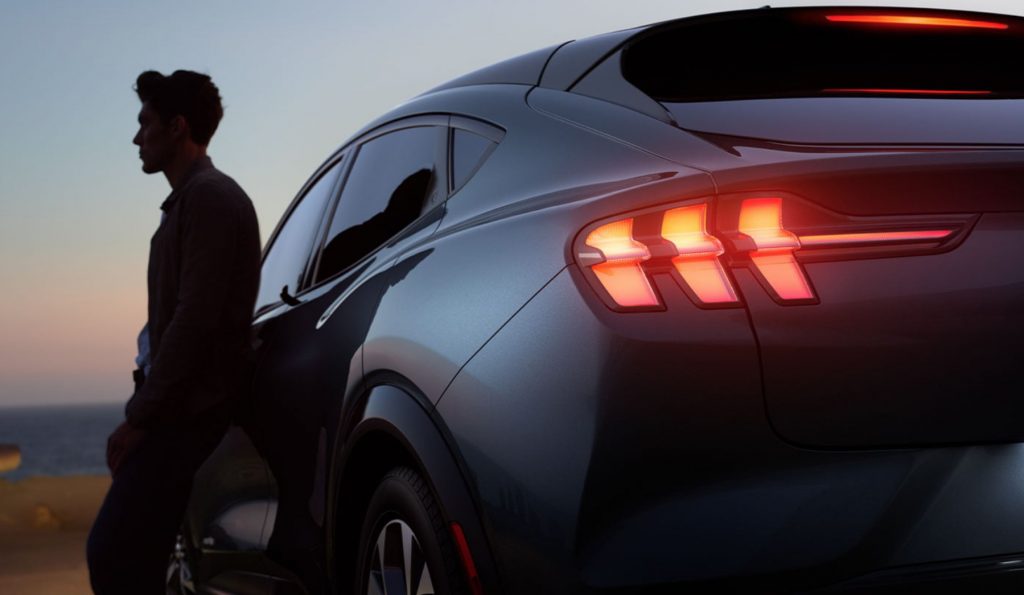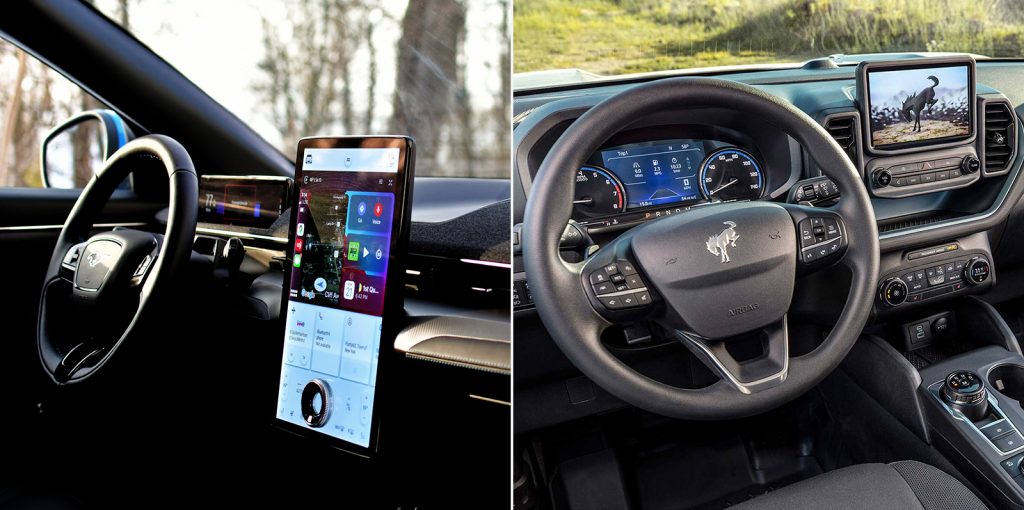Comparing the Electric Mustang Mach-E + Bronco Sport
Two very different vehicles underpinned by the same design thinking

Ford‘s all-new Mustang Mach-E and Bronco Sport have more in common than meets the eye. Though the appearance of the two vehicles differs, it’s the thinking behind them that tells us plenty about Ford’s current approach to car design—one fueled by not only a need to compete with other brands in the space, but also extensive consumer research.

To understand Ford’s thinking, it’s helpful to begin by contemplating the brand’s position in the market. One out of every 20 vehicles sold in the US last year was Ford’s hefty F-150 pick-up—more than 787,000 of them. Put another way, the F-150 alone accounts for about seven times the number of all Volvos sold and 200,000 more cars than Kia sold in the US last year. This is important because Volvo and Kia are currently design darlings to many auto journalists (and their buyers), and both brands are seeing increasing sales because of their focus on design. Ford’s stalwart pick-up suggests that the brand is fine not being a design leader, but that’s not necessarily the case.
Additionally, Tesla has put American carmakers on high alert. To other US-based automotive brands, the fact that Tesla has done so much so fast in their own home market has pushed the entire industry forward. Ford invested $500 million in electric start-up truck/SUV-maker Rivian a few years back, while General Motors (who own Buick, Cadillac, Chevrolet, Hummer and GMC) intends on spending $27 billion to launch 30 new electric vehicles by 2025.

Both the non-electric Bronco Sport (starting at $26,280) and the electric Mustang Mach-E (starting at $44,995) demonstrate the kind of design thinking that can bridge the gap between different types of customers. Ford knows who they are, and who they appeal to. They do more consumer research than most every other manufacturer. They know that to rival Tesla (and every other brand in the EV automotive future) they cannot play it safe. They have achieved that with the two new vehicles by harnessing legacy brands from very different portions of their portfolio and carrying both the Mustang and Bronco nameplates into an entirely new space (one with almost certainly new, younger customers) and by painting unique canvases for each.

Sitting behind the wheel of each vehicle it’s clear they share an underlying ethos. The Mustang Mach-E houses a lot of its controls in an oversized, 15.5-inch touchscreen, popular in the EV space. The Bronco Sport has a lot of hard and large controls, yet driving each and adjusting functions is relatively intuitive in a way that’s profoundly refreshing. On the Bronco Sport, that means knobs—for audio volume and tuning, and climate control—are chunky and obvious, and even the rotary shift dial (while a bit overtly signaling the machismo linked with SUVs) isn’t cartoonishly massive. Likewise, adjusting temperature or switching audio sources on the huge screen in the Mustang Mach-E works easily because Ford kept the car’s function fields distinct from those of your paired phone, and made sure the latter are always displayed.

The rest of the Mustang Mach-E cabin is quite gracefully executed, with a fabric-like upper dash surface that’s actually a sound bar, and car-width dashboard venting. A fixed, dark, panoramic roof also helps a relatively compact interior feel more spacious, too. The Bronco Sport’s interior is roomier than one might assume. Cargo space isn’t astounding, but it has a decent capacity and there are plenty of thoughtfully designed bins, cutouts and cubbies.
Despite one’s sleekness and the other’s tool-belt aesthetic, the underlying pragmatism of both vehicles proves paramount. The Mustang Mach-E isn’t the purest of designs (it looks a bit more muscular and a bit less taut than it could), but if Ford is going to grow Mach-E into its own sub-brand of electrics, the shape can be viewed differently. It easily stretches to the size of an Explorer, and it can reduce down into a cute ute. Get the version with a 88kWh battery and you’ll see range of roughly 300 miles—though you won’t have access to Tesla’s Supercharger network, Ford claims to have 13,500 charging locations currently available. Fast DC charging can juice up your electric Mustang from 10 to 80 percent in 45 minutes.)

The Bronco Sport, meanwhile, is proportionally just about perfect. From the chunky monicker both front and rear to the clamshell hood, the dead-stop backside (which cleverly folds both as a tailgate and has a functional rear window so you can reach inside to grab your groceries, hiking boots or snowboard), all visual aspects of the Bronco Sport signal adventure.
What Ford did especially well is not cost cut away any obvious visual shortcuts. The Bronco Sport has a solid, no-fuss appeal that’s refined, smooth and predictable.

The Mustang Mach-E is saying something else entirely, and time will tell if buyers are attracted to its specific looks. It’s distinctive and doesn’t look like it wants to be a Tesla (a mistake some brands seem to be making with their EVs), nor does it look so conventional you wouldn’t presume it runs on electrons. In fact, many people who saw the car came up to us and immediately knew what it was—or at least knew it was electric.
That says, at least anecdotally, that Ford has gotten enough right to signal change. Maybe that change means Ford will soon lean even further into design. If these two cars are any indication, that would be great for fans of American cars that aren’t made by tech companies.
Hero image courtesy of Ford












